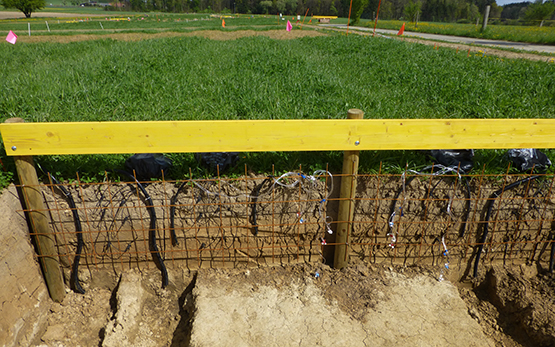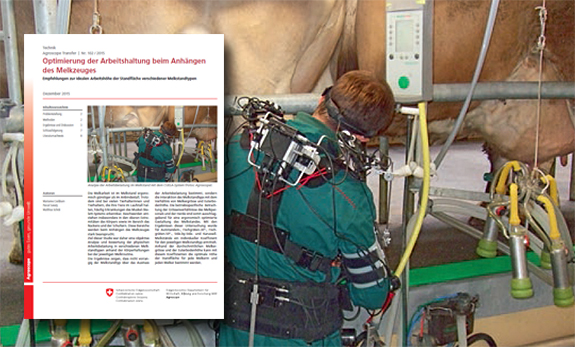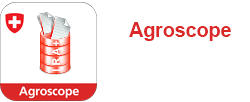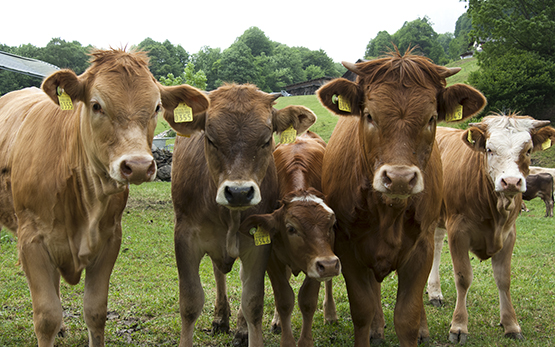Fuchs P., Pauler C., Schneider M. K., Umstätter C., Rufener C., Wechsler B., Bruckmaier M. R., Probo M.
Implementation of virtual fencing in heifers for mountain summer grazing.
Journal of Animal Science, 102, (S3), 2024.
Fuchs P., Schneider M. K., Pauler C., Confessore A., Umstätter C., Probo M.
Virtual fencing for managing lactating Holstein Friesian cows and its effect on animal welfare.
In: BOLFA & ICFAE. 28-30 August, Ed. University of Bern / EAAP / ASAS, Bern. 2024.
Pauler C., Fuchs P., Schneider M. K., Hervault P., Umstätter C., Bruckmaier R. M., Probo M.
Implementation of virtual fencing in mountain conditions.
In: 3rd Mountain Livestock Farming Systems Meeting. 5-7 June, Ed. EAAP / VetAgro Sup / INRAE, Clermont-Ferrand (FR). 2024, 62.
Confessore A., Schneider M. K., Pauler C., Aquilani C., Fuchs P., Pugliese C., Dibari C., Argenti G., Accorsi P.A., Probo M.
A matter of age ?: How age affects the adaptation of lactating dairy cows to virtual fencing.
Journal of Animal Science, 102, (137), 2024.
Probo M., Fuchs P., Schneider M. K., Hervault P., Umstätter P., Bruckmaier R. M., Pauler C.
Are virtual fences applicable in mountain pastures?
Grassland Science in Europe, 29, 2024, 505-507.
Meyer M., Fuchs P., Pauler C., Schneider M. K., Probo M.
Potential und Wirtschaftlichkeit virtueller Zäune.
In: Fachtagung Landtechnik im Alpenraum. 4. April, Feldkirch. 2024, 1-17.
Fuchs P., Stachowicz J., Schneider M. K., Probo M., Bruckmaier R. M., Umstätter C.
Stress indicators in dairy cows adapting to virtual fencing.
Journal of Animal Science, 102, 2024, 1-17.
Confessore A., Schneider M. K., Pauler C., Aquilani C., Fuchs P., Pugliese C., Dibari C., Argenti G., Probo M.
Does age affect learning capacity and grazing activities of dairy cows managed with a virtual fencing system?
In: AgroVet-Strickhof Tagung: Vernetzung von Forschung und Praxis - mit smarter Tierhaltung in die Zukunft. 07 November, Lindau. 2023.
Fuchs P., Stachowicz J., Schneider M. K., Probo M., Bruckmaier R. M., Umstätter C.
Conditioning dairy cows to a virtual fencing system is compatible with animal welfare.
In: ASAS-CSAS-WSASAS Annual Meeting. 16 July, Ed. American Society of Animal Science, Albuquerque. 2023, 334-335.
Fuchs P., Stachowicz J., Schneider M. K., Probo M., Bruckmaier R., Umstätter C.
Welche Auswirkungen hat die Anpassung von Milchkühen an ein virtuelles Zaunsystem auf das Tierwohl und das Weidemanagement?
In: AgroVet-Strickhof Tagung: Vernetzung von Forschung und Praxis - mit smarter Tierhaltung in die Zukunft. 7. November, Ed. AgroVet-Strickhof, Lindau. 2023, 1-12.
Fuchs P., Stachowicz J., Schneider M. K., Probo M., Bruckmaier R., Umstätter C.
Behavioral and welfare responses of dairy cows learning a virtual fencing system.
In: Book of Abstracts of the 74th Annual Meeting of the European Federation of Animal Science. 26 August – 1 September, Ed. EAAP, Lyon (FR). 2023, 1-11.
Confessore A., Aquilani C., Fuchs P., Probo M., Pauler C., Schneider M. K., Argenti G., Pugliese C.
Does age affect learning capacity and grazing activities of Holstein cows managed with virtual fencing collars?
Italian Journal of Animal Science, 22, (1), 2023, 162.
Fuchs P., Stachowicz J., Schneider M. K., Probo M., Bruckmaier R., Umstätter C.
Does the use of a virtual fencing system affect dairy cow welfare?
In: Annual GCB Symposium 2023. 29. June, Ed. University of Bern, Bern. 2023.
Fuchs P., Stachowicz J. , Schneider M. K., Probo M., Bruckmaier R., Umstätter C.
Learning behavior and milk cortisol levels of dairy cows managed under a rotational grazing system with virtual fencing.
In: 3rd Agroscope PhD-PostDoc Symposium. 13. Oktober, Ed. Agroscope, Changins. 2022.
Fuchs P., Stachowicz J., Schneider M. K., Probo M., Bruckmaier R., Umstätter C.
Learning behavior and welfare of dairy cows using a virtual fencing system in rotational grazing.
In: 73º Annual Meeting of European Federation of Animal Science. 5. - 9. September, Ed. EAAP, Porto, Portugal. 2022, 1-13.
Fuchs P., Adrion F., Shafiullah A.Z.M., Bruckmaier R., Umstätter C.
Detecting ultra- and circadian activity rhythms of dairy cows in automatic milking systems using the degree of functional coupling: A pilot study.
Frontiers in Animal Science, 3, 2022, 1-15.
Stachowicz J., Fuchs P., Umstätter C.
Virtuelle Zaunsysteme – Hightech in der Weidewirtschaft.
In: „Smart Barning“ – Digitalisierung in der Nutztierhaltung. Ed. Internationale Gesellschaft für Nutztierhaltung (IGN), München. 2021, 74-76.
Fuchs P., Adrion F., Shafiullah A. Z. M., Bruckmaier R., Umstätter C.
Untersuchungen zur Rhythmizität und zur Melatoninkonzentration von Milchkühen auf Betrieben mit Automatischem Melksystem.
In: Gemeinsame Melktechniktagung 2020 - Agroscope und AGRIDEA. September, Ed. AGRIDEA, Lindau. 2020, 80-87.









